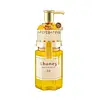What's inside
What's inside
 Key Ingredients
Key Ingredients

 Benefits
Benefits

 Concerns
Concerns

 Ingredients Side-by-side
Ingredients Side-by-side

Cyclopentasiloxane
EmollientDimethicone
EmollientHydrogenated Polyisobutene
EmollientElaeis Guineensis Kernel Oil
EmollientHoney
HumectantHoney Extract
HumectantHydrolyzed Honey Protein
Skin ConditioningRosa Damascena Flower Extract
MaskingArgania Spinosa Kernel Oil
EmollientPanthenol
Skin ConditioningGluconobacter/Honey Ferment Filtrate
Skin ConditioningKeratin
Skin ConditioningRoyal Jelly Extract
Skin ConditioningPropolis Extract
Skin ConditioningC9-11 Alkyl Glucoside
CleansingHydroxypropyltrimonium Hyaluronate
Ceramide Ng
Skin ConditioningCeramide NP
Skin ConditioningCeramide AP
Skin ConditioningHydrolyzed Silk
HumectantGlycerin
HumectantTocopherol
AntioxidantQuaternium-18
Quaternium-33
Cholesterol
EmollientButylene Glycol
HumectantPropylene Glycol
HumectantPhenoxyethanol
PreservativeWater
Skin ConditioningParfum
MaskingCyclopentasiloxane, Dimethicone, Hydrogenated Polyisobutene, Elaeis Guineensis Kernel Oil, Honey, Honey Extract, Hydrolyzed Honey Protein, Rosa Damascena Flower Extract, Argania Spinosa Kernel Oil, Panthenol, Gluconobacter/Honey Ferment Filtrate, Keratin, Royal Jelly Extract, Propolis Extract, C9-11 Alkyl Glucoside, Hydroxypropyltrimonium Hyaluronate, Ceramide Ng, Ceramide NP, Ceramide AP, Hydrolyzed Silk, Glycerin, Tocopherol, Quaternium-18, Quaternium-33, Cholesterol, Butylene Glycol, Propylene Glycol, Phenoxyethanol, Water, Parfum
 Reviews
Reviews

Ingredients Explained
These ingredients are found in both products.
Ingredients higher up in an ingredient list are typically present in a larger amount.
Dimethicone is a type of synthetic silicone created from natural materials such as quartz.
What it does:
Dimethicone comes in different viscosities:
Depending on the viscosity, dimethicone has different properties.
Ingredients lists don't always show which type is used, so we recommend reaching out to the brand if you have questions about the viscosity.
This ingredient is unlikely to cause irritation because it does not get absorbed into skin. However, people with silicone allergies should be careful about using this ingredient.
Note: Dimethicone may contribute to pilling. This is because it is not oil or water soluble, so pilling may occur when layered with products. When mixed with heavy oils in a formula, the outcome is also quite greasy.
Learn more about DimethiconeHydrogenated Polyisobutene is a synthetic polymer. Polymers are compounds with high molecular weight. Hydrogenated Polyisobutene is an emollient and texture enhancer.
In one study, Hydrogenated Polyisobutene showed better skin hydration levels than Caprylic/Capric Triglyceride. As an emollient, it helps keep your skin soft and hydrated by trapping moisture in.
Hydrogenated Polyisobutene is often used as a mineral oil replacement.
Learn more about Hydrogenated PolyisobuteneParfum is a catch-all term for an ingredient or more that is used to give a scent to products.
Also called "fragrance", this ingredient can be a blend of hundreds of chemicals or plant oils. This means every product with "fragrance" or "parfum" in the ingredients list is a different mixture.
For instance, Habanolide is a proprietary trade name for a specific aroma chemical. When used as a fragrance ingredient in cosmetics, most aroma chemicals fall under the broad labeling category of “FRAGRANCE” or “PARFUM” according to EU and US regulations.
The term 'parfum' or 'fragrance' is not regulated in many countries. In many cases, it is up to the brand to define this term.
For instance, many brands choose to label themselves as "fragrance-free" because they are not using synthetic fragrances. However, their products may still contain ingredients such as essential oils that are considered a fragrance by INCI standards.
One example is Calendula flower extract. Calendula is an essential oil that still imparts a scent or 'fragrance'.
Depending on the blend, the ingredients in the mixture can cause allergies and sensitivities on the skin. Some ingredients that are known EU allergens include linalool and citronellol.
Parfum can also be used to mask or cover an unpleasant scent.
The bottom line is: not all fragrances/parfum/ingredients are created equally. If you are worried about fragrances, we recommend taking a closer look at an ingredient. And of course, we always recommend speaking with a professional.
Learn more about ParfumTocopherol (also known as Vitamin E) is a common antioxidant used to help protect the skin from free-radicals and strengthen the skin barrier. It's also fat soluble - this means our skin is great at absorbing it.
Vitamin E also helps keep your natural skin lipids healthy. Your lipid skin barrier naturally consists of lipids, ceramides, and fatty acids. Vitamin E offers extra protection for your skin’s lipid barrier, keeping your skin healthy and nourished.
Another benefit is a bit of UV protection. Vitamin E helps reduce the damage caused by UVB rays. (It should not replace your sunscreen). Combining it with Vitamin C can decrease sunburned cells and hyperpigmentation after UV exposure.
You might have noticed Vitamin E + C often paired together. This is because it is great at stabilizing Vitamin C. Using the two together helps increase the effectiveness of both ingredients.
There are often claims that Vitamin E can reduce/prevent scarring, but these claims haven't been confirmed by scientific research.
Learn more about Tocopherol